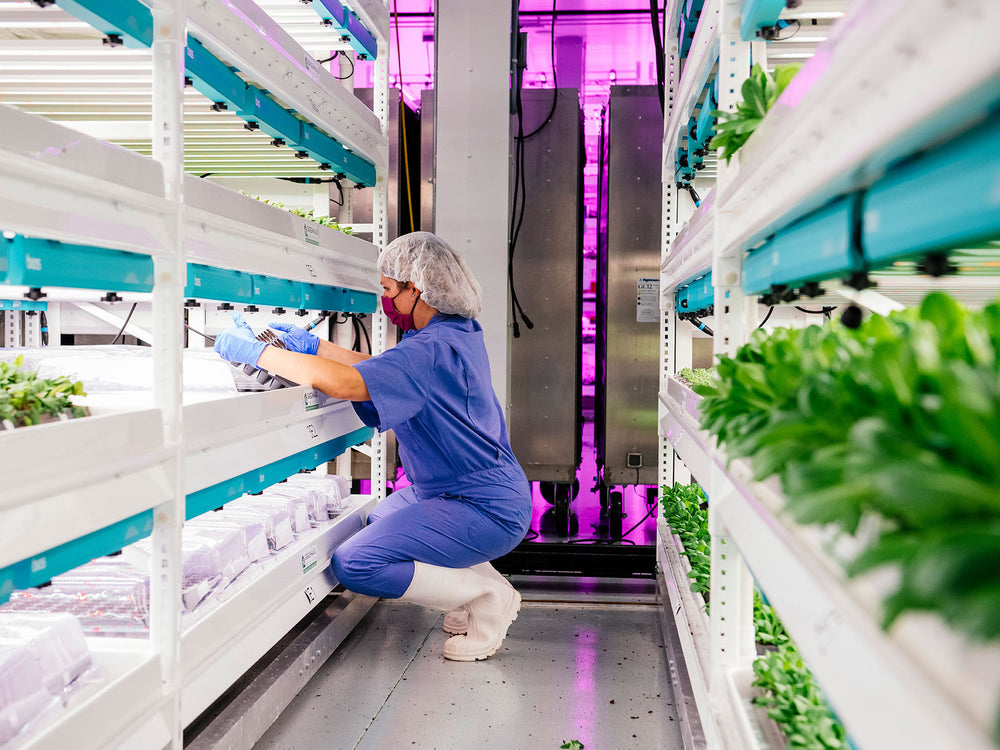
AmHydro has been designing and building hydroponic systems for over 40 years. Every couple of months they choose someone from the CEA industry to highlight and this past month they featured our very own Leader of Plant Health, Kelly Sharpe!

Meet Featured Grower Kelly Sharpe
This month’s featured grower is Kelly Sharpe, the Leader of Plant Health & Employee Success at Planted Detroit, a hydroponic controlled environment vertical farm growing baby greens, microgreens, and herbs in the Islandview neighborhood on the city’s eastside.
As the head of Operations & Horticulture, Kelly ensures that each of the plants in Planted Detroit’s 20,000 sq. ft. facility has everything it needs from seed to pack. Kelly’s team produces approximately 2,600 pounds of greens a month which they sell wholesale to local restaurants or as ready-to-eat salads directly to consumers across Southeast Michigan.
A native of Michigan, Kelly, along with the rest of the Planted Detroit team, believes healthy, nutrient packed food is not a privilege but right that everyone should have access to. She works to grow roughly 25 varieties of sustainably sourced and grown greens right in Detroit.
Tell us a little bit about yourself and your role on the farm. What do your day to day responsibilities look like?
Well, my official title is “Leader of Plant Health and Employee Success,” and really that’s a great summary of my focus on both people and plants, because you need both to thrive if you want to succeed and move the needle. I have a lot of responsibilities: team check ins, individual check ins, and overseeing that our processes are still working for people and plants. My horticulture team and I are always analyzing the numbers and variables.
Really, the goal of all the titles and to-do lists comes down to this: My role is to help our team to grow a better plant.
That might sound simple, but a better plant means many things to many people. Culinarily, a better plant is all about color, taste, and texture, which leads us to make adjustments to get different amounts of sugars or oils. Horticulturally, a better plant can mean better yield, or a specific size and quantity. Of course, we also process and sell our leafy greens directly to consumers, so a better plant also needs to be perfectly forkable and ready to eat.
When did you first come to start working with hydroponics and controlled environment agriculture? Was that an initial part of your farming journey, or something you were exposed to later?
I actually spent a few decades in horticulture before I came to hydroponics.
After graduating from Michigan State University, I initially went into the golf course industry, and spent twenty years learning just about everything there is to know about turf. Which is not what I planned on! But during that period, I also spent a lot of time thinking about how we treat land, and as a hobbyist I became invested in learning about food, supply chains, and eventually Controlled Environment Agriculture.
Planted Detroit was my first experience working daily with hydroponics. Our founder, Tom Adamczyk, asked me to come along for the ride, and it’s been an adventure since day one. Really I had to learn to set aside everything I knew about working with plants. Forget about wide open golf courses, we’re now spending our days indoors.
But plants are still plants, and I get a lot of satisfaction about learning how to meet their needs and help them flourish.
I will say, compared with my experiences in the world of outdoor agriculture, I was surprised by the culture of indoor. I was used to data sharing and collaboration being the norm, but there’s not a lot of sharing in indoor agriculture.
To move the industry along, we need to find a way to share data and collaboratively move things forward, otherwise we’re just competing to be big fishes in a small pond.
Faced with this lack of resource and data sharing, were there any resources that you did find helpful?
To be honest, we felt like we had to learn it from scratch. Of course there were books and online resources. But using those felt like mostly learning theory. We still had to figure out how to apply and test it on our own.
Actually, there was one thing that was a huge boost. We asked Joe Swartz from AmHydro to come out as a consultant at the beginning, and their CEO Jenny Harris came too. We told him we didn’t want to reinvent the wheel, and we wanted him to tell us where people have failed and not listened; to tell us where to focus and where to be agnostic. Joe was a great resource. He speaks the truth.
What has it been like to work with AmHydro and AmHydro Equipment?
I don’t want to oversell it, but honestly Joe was everything. He helped us gain a realistic perspective on the CEA industry which we’re so thankful for.
Originally we chose AmHydro gutters for two main reasons. First, the fact that they’re composed of food safe material. This was so important to us because food safety was one of our core principles.
The second reason is that our research led us to conclude that, frankly, they were designed with the plants in mind. When we were getting started it seemed (and it still seems) like the industry has focused on tech, and sort of forgotten that first and foremost we’re in the business of growing plants.
What’s the biggest piece of advice you’d share with someone who is just starting out in hydroponic farming?
Think outside the box. Everything you think you know about plants and environment, put it aside and be willing to have a different perspective.
Be science-minded. You have some big ideas about improving efficiency?
You think you see a niche that no one else is filling?
That’s good! But test those ideas. Gain data, and allow that to drive your decisions and progress.
Some farmers and consumers question whether hydroponics can grow produce as effectively and deliciously as soil. What would you say to people who have these doubts?
Doubts are normal, and doubts should exist. Because that’s science based! Question everything.
Some people may have preconceptions about how hydroponic greens taste, but what we have is actual feedback from chefs and consumers. Chefs in particular, who spend a lot of time trying to find the best ingredients for their menus, tell us our products are beautiful and flavorful.
That said, the pie in the sky dream for me is that traditional agriculture and CEA farming can coexist and actually support one another.
Each industry does specific things very well. Why would we not support one another?
We’re using science to tweak variables in our products to get these wonderful results. But we’re not growing fields of potatoes. Traditional agriculture does that better. We can’t replace that, we want to coexist.
What’s your favorite part about helping to run a hydroponic farm?
There are so many things, but honestly it’s the people for me. We have around 75 employees now, roughly 50 of whom work in production. We’re all working together to take on the challenge of designing a roadmap for the industry that we could follow for the next few hundred years. We’re just in the infancy of this new industry.
I also love that this company gives me the chance to support the local community – through food, but also through careers (emphasis on “careers” here, not just jobs!) We’re not just feeding, we’re teaching people how to farm. Wherever we expand in the community, we want to contribute to that community.
It’s not just about how cool our tech is. It’s about the people and the plants.
